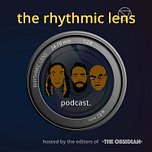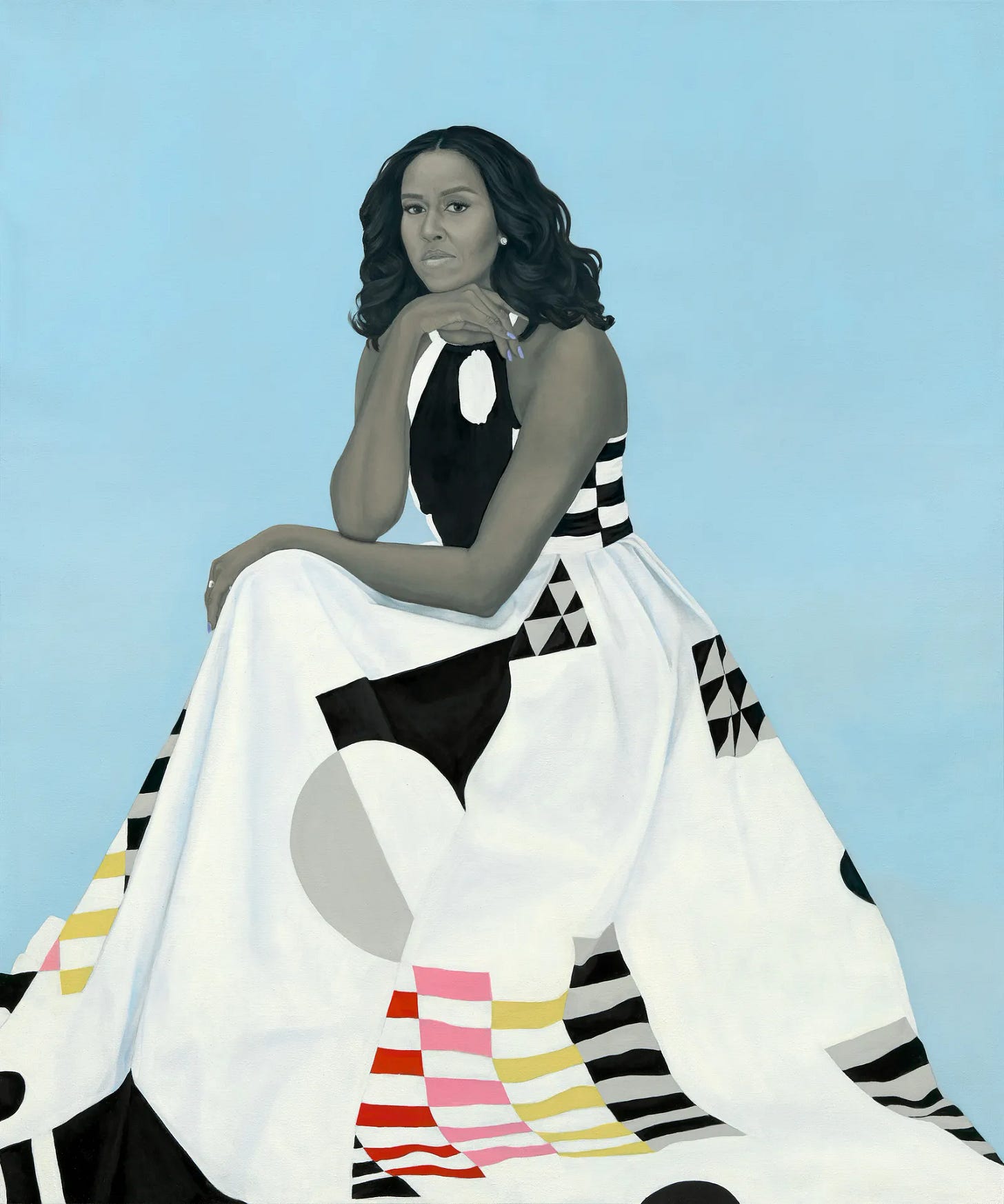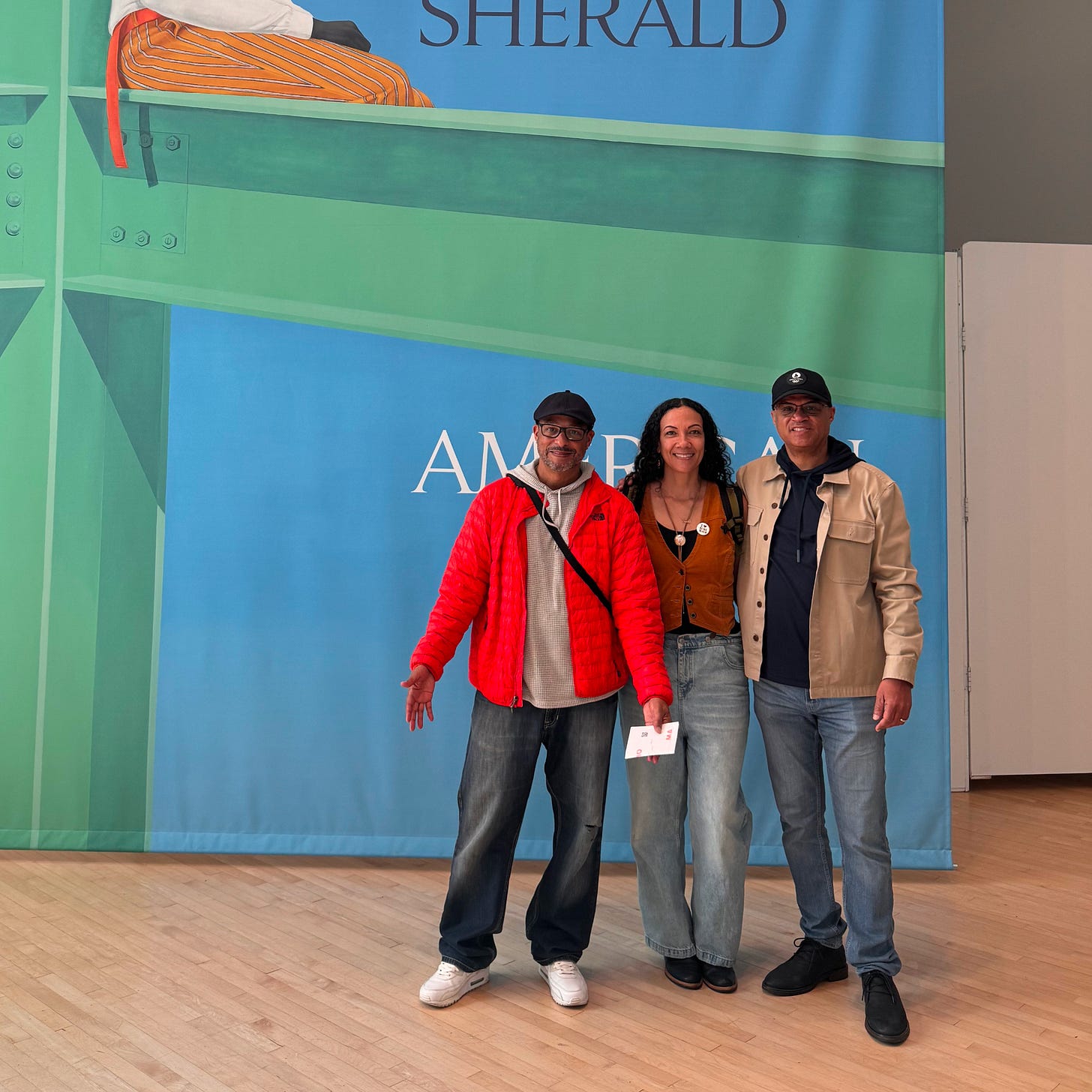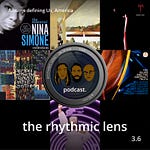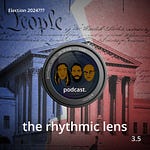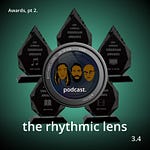Episode 4.2. In this deeply personal episode of The Rhythmic Lens, Jason, Kim, and Ron reflect on Amy Sherald’s exhibit American Sublime—a celebration of Black life through intimate, impactful portraits that radiate quiet dignity and visual power through her creative use of “Grisaille,” a form of grayscale. The hosts explore how Sherald’s work reclaims space for Black stories often overlooked in traditional portraiture and how it reclaims the everyday as extraordinary—inspiring deeper conversations about self-respect, education, and a quest for excellence in the face of the prevailing winds.
A classroom story from Kim becomes the emotional and moral heart of the episode, revealing how art—and educators—must step up when prejudice surfaces early. It’s an episode about beauty, memory, visibility, and the long game of cultural truth.
Transcript
Jason: [00:00:00] Yo. This is the Rhythmic Lens, a podcast that explores arts and life by siping on the events, new releases and issues of the day by the editors of the Obsidian. I'm Jason.
Kim: I'm Kim.
Ron: And I'm Ron.
Jason: That's right now. Okay. How you guys doing? It is, it is. It is great. To see you, to hear your voices. The Rhythmic Lens 2025.
And you know what, we're gonna, we're gonna play with the Lens a little bit, but first I gotta ask Kim, what's in your glass?
Kim: Well, oh, sorry. That was my coaster falling. Oh. In a regular old water glass. 'cause I don't have any wine glasses. I am sipping some rose today.
Jason: Ooh, very nice. Yeah, [00:01:00] actually that looks like a old jar.
Kim: It is actually. An old jar of raspberry jam.
Ron: I was definitely gonna call that out. All that was, that is clearly a jar. That is not a, that's not even a, that is a jar. That's not even a water glass. But you got a coaster, right?
Kim: I got a coaster.
Ron: Classy. You got a coaster for your jar.
Kim: I'm classy. Yeah.
Ron: What kind of wine was that?
Kim: I don't know the name, it's just Rose and I don't even really like wine that much, but it was a gift
Ron: Uhhuh,
Kim: and I'm trying to be a little more, uh, you know, classy, refined.
Ron: Okay. Okay. Yes. That looked like you was drinking some "Beaujolais" or sumthin,
Kim: I don't even know what that is. No clue.
Jason: All right. What kind of refined beverage do you have?
Ron: Tonight I am rocking some Gentleman's Cut, which is the Steph Curry Bourbon. Alright, figure. You know, we're talking [00:02:00] about, progressions and all that. So, support Steph.
Jason: Fantastic.
You're gonna have three of those. Okay. Three point.
Ron: What do you, what makes you think I haven't?
Jason: My bad. Alright.
Kim: By the way, Jason was slurring. What do you have?
Jason: Yeah, Jay. Hey. And so I got a mug and this is my, this is my Charles Lloyd bug by the way. This is, you know, the greatest living jazz saxophones around and inside I actually have some Colombian brew coffee. I'm just, just going for it like that. All right.
So it's not early, so I'm a bit daring in that. Are I bringing, are you you feeling ill or
Ron: something, or? No, not at all. Felt like tee totaling. Okay. It's all good. I just, just the mood,
Jason: uh, it is just the mood. I I'm not trying to put any pressure on you or anything. No, [00:03:00] no, no, no. I'm awake. Which some people would say you've, you know, earlier you are.
You are. Aw. Woke. Or whoa, right? It means my eyes are open and yes, I can see the cultural moment. I don't know. And I think you guys can too.
Kim: Wow. You got all that from the coffee?
Jason: Told you Charles Lloyd, man, if you haven't heard, you know, forest flower, go, go listen, but okay. You know, and it, this moment is isn't just about politics, but the future is now.
Right. And things are shifting and in a way that we don't know where it's gonna end up. And I'm being very general here at this moment, but there are people who have a strategy. On how to move through the moment [00:04:00] and they're already doing it. And sometimes we just have to open our eyes or shift the perspective of the lens and point it in a direction that gives you vision, that tells the story that you know the path that you've tread and The Rhythmic Lens is gonna focus on that.
Ron, what do you say?
Ron: Yeah, definitely, man. I think we're definitely in a moment here. With the folks that give themselves these four letter acronyms the MAGA and the Doge, they're definitely feeling it right now, right? They just going with reckless abandon and they're doing their thing.
And basically what they're trying to do is crush DEI wherever they can, and that like, [00:05:00] that's become a demonic word. They're trying to root it out everywhere. But you think about what is DEI? It's diversity, equity, and inclusion, which are virtues, which are words that shouldn't be controversial at all. If you are against diversity, equity, and inclusion, I guess you're for homogeneity, which means everything is the same and you're for privilege. 'cause that's the opposite of equity and you're for exclusion and let's exclude people.
And you know, by the people that are doing it, you know, who they're trying to exclude. So that's our environment. But what we've always known here at the Lens, we've always said that the arts and life are one. And we know that the culture is gonna point the way in a lot of ways, and that's where we're gonna keep the Lens focused.
We believe that culture is going to point, the way forward is the culture in our [00:06:00] music and in our art and in our literature is going to inspire new leadership because we need some new leadership. Y'all, I don't care what side of the spectrum you are on, this can't be it. And so, we are definitely looking forward to pointing out how the art is going to lead us.
And, Kim can tell best. About the artist that we're going to start out with on in this episode. But that's what we're gonna be doing with the Lens. We're just gonna keep looking at the artists and the musicians and the writers and all that that is leading the way for us.
What do you think, Kim?
Kim: I think it sounds amazing, and we decided to kick this off with an artist by the name of Amy. Sherrold, and why we're starting with Amy. One of the reasons [00:07:00] is that she recently had a exhibit at the SF, MOMA which we'll get to more on that later. And I went to see the exhibit.
And was absolutely blown away. And then I said to Jason, Ron, we should go check this out. And so we did. So a little bit about Amy. Her work embodies exactly what we were talking about. She takes the everyday black experience. She kind of strips away the distortion of the white gaze.
It's just intermingled forcibly into the fabric of our lives, unfortunately. So she strips that away and presents us. Black people in a way that is dignified, that is visually stunning. I consider it to be of genius level skillset, yet it's also somehow uncomplicated and is quietly incredibly powerful.
The name of her current tour, that recently just [00:08:00] left the SF MOMA is American Sublime, and I feel like it couldn't be more perfect because her portraits are absolutely the embodiment of both of those words, and she's been doing it a long time, long before she gained recognition as Michelle Obama's official portrait artist in 2018.
So she was born in Columbus, Georgia in 1973, and she, if you don't know her work, she works mostly as a portraitist. Depicting African Americans in everyday settings, but very intimately. And she challenges the traditional representation of black identity. Her style is simplified realism. It involves stage photographs of her subject, but she actually calls, she'll stop people on the street and say, Hey, will you model for me?
And she said that actually only one person has ever said no. So here I am, like I wanna go. I wanna go to, I think she's in Atlanta now, and just walk around where she. Works and hope. She'll be like, Hey, would you be, I would love to be, I wanna a model for her. That'd be amazing. Mm-hmm. [00:09:00] But she just picks people off the street and brings them in, dresses them up in whatever she has in envisioned in her mind, and takes a bunch of photos of them.
And then she'll use those photos side by side on her canvases to, um, create her beautiful portraits using everyday people, literally everyday people. And she uses a signature gray scale technique. It's called "Grisaille", which is a French, it's a, it's for her subject skin tones and just for the skin tone. So the skin tones and hair are in this Grisaille technique, and her aim in that is to focus the attention on their interior lives rather than their outwards identities or race. By the way, Grisaille is a 16th century technique that was actually used for underpainting and now she's taken it and made it like the feature of her pieces.
Ron: So when you say underpainting, you mean like they would start how By painting it Grisaille and they would color it after.
Kim: Yes. So a lot of 16th century artists, they would put the [00:10:00] Grisaille underneath and then they would add layers of color on top of it. And that allowed them to have like more translucent layers to build and it made it more of a three-dimensional effect. But it wasn't underpainting, it wasn't like the focus.
And she's taken that technique and made it like the focus. And that's kind of what she's known for now. So since 2012, she's used shades of gray her choice to portray skin tones, and she describes it as a choice that is intended to challenge conventions about skin color and race. And her portraits are absolutely stunning.
Ron: Yeah, definitely, definitely. I mean, I don't want to jump ahead, but I would just say that technique, it really grabs you, really grabs you.
Kim: For sure.
Jason: Mm. No. And that is in a lot of ways the experience that we had. 'cause Kim said, look y'all, we gotta go and mm-hmm. So we did a field trip and the SF MOMA is a special [00:11:00] place.
It's a beautiful museum. It's south of Market Street in San Francisco.
Mm-hmm.
Jason: On third. Between Howard and Mission and it was a beautiful day. The sky was crisp blue, and San Francisco promises a sight wherever you go from people to the city itself by the bay. And it was just a gorgeous day and it didn't disappoint.
Kim: I just have to jump in and say that I was very honored that I had this interesting experience and it happened right before we went in the exhibit. I went to the cafe and there was. The cashier behind the counter when I, mm-hmm. When I stepped up, I had this little kind of aside with like his friend, a coworker.
He's like, and I was like, what's happening here? I'm trying to order. Okay. And then he said, he looked at me, he said, are you the artist? And I was like, what?
Uh
Kim: huh. I had no idea what he was talking about. [00:12:00] And they said. You're the artist, right? And I was like, oh, no, no, no, no. Oh my gosh, gosh. As I realized at the moment, he thought that I, I think he thought that I was Amy.
She and I was like, oh, I'm honored, but no, I'm not her. I was like, but I'm an art teacher and I work. And he's like, I'll give you, I'll give you the, the member's discount. So I got a little discount. 'cause he thought it was her.
Jason: You were getting ready to get sent home with your own paintings.
I be like, I need this one. I was so honored.
Ron: Well, we just call you Amy from now on.
Kim: I wish call. Wow. I know. Call you
Ron: Amy. I guess that's what I told him. I was
Kim: like, I wish. Anyway.
Ron: Basically a light skinned, good looking woman. You must be a artist.
Kim: That was pretty funny. Pretty funny.
Ron: Yeah it's a compliment. It's a compliment.
Kim: Yeah. Oh, I was honored for sure.
Ron: But, it's also in a weird way, it just kind of [00:13:00] illustrates what Amy is trying to communicate in her art, right? About us, right? Because we're what's the word I'm looking for, right?
It's, um. It's a word that, uh, oh my, I can't, I wanted to say, trying
to say like, people don't necessarily differentiate us so much. Correct. They kind of see like, like you said, a light-skinned black woman and Yes, I could be me, I could be Amy. Sherald.
Exactly, yeah, that's what I'm trying to say. Thank you.
Kim: I felt that too, like I was honored 'cause it's Amy Sherald, but I was also like
Ron: mm-hmm.
Kim: What? You're not really seeing me really, because if you look a little closer,
Ron: but maybe if you were walking around in gray scale. Right.
But I have to tell you, when you looked at her portraits, like you said, they were. Ordinary people.
Kim: Yeah.
Ron: I [00:14:00] think that was one of the first things I said when I, I think I said it to Jason, I said, these people look like people I know.
Yes, yes.
Ron: That's when I was, it was like, I'm, at a, like a family like reunion or something here.
It was like, I know that person. Her depiction of the person in that particular portrait, I think by the technique that she uses, it lets you really see the person.
Yeah. They,
Ron: they become really, really real. Yeah. And it's like, and every one of the portraits, there's like a very like obvious dignity. Yes. But it's like a dignity without saying, Hey, look at me, I'm dignified. Right. It's just I'm me and it's like it's me and I am enough. You know? Right. And, and the people that [00:15:00] that are in there, we always have been. Exactly. Um, yeah. So that was like thank you for sharing that with us.
Kim: Yeah, thank you. And that's kind of like what I meant when I said uncomplicated because
Ron: mm-hmm.
Kim: Um, we so often are not allowed to just be, it's, you know, there's always something else ascribed to it. And I think that's one, one of the, something that's added on. I think that's one of the things that where the gray scale came from and her meaning behind it too is that, it's just people doing things that they do every day and being just beautiful and stunning because that's who we are. Right. And seeing ourselves and seeing, like I saw a, I was like that, that, that looks like my student that I'm thinking of in like, you know, five years from now he's, he looks like that kid right there in this in the beach scene.
Right. And
Kim: I also think it's, I just had a weird connection from what you said to the idea, that I think a lot of people, a lot of white or non-black Americans miss out on, is that, I think [00:16:00] maybe is part of the many facets of the problem is that when you see someone, on the street who's black, you, you identify often can identify and say, oh, they, you, you have a reference.
For that. A lot of people don't have, like mm-hmm. I might see, um, a man crossing the street who's older and maybe, his clothes are not like super sharp or maybe even not even clean. And maybe he is unhoused, but I see my dad and I'm like, ah, that guy with my dad.
So that's a connection that you can make that allows you to see them differently. That a lot of people don't have a reference for.
Ron: What was your favorite piece? Both of you guys?
Kim: You wanna, I know
Ron: mine. I know mine. Should I share mine first?
Kim: Yeah.
Ron: So there was a piece where it was two young men and they had two young ladies.
They were at the beach and they were carrying the ladies [00:17:00] on their shoulders. And it was like took you back to like high school and just that time of innocence and just fun. But also, again, just to kind of point back to, without even saying it, just that that quiet dignity, like, you know, we're here, we're of the world and we're beautiful and I don't know. For some reason piece really spoke to me. What about you, Jason?
Jason: Yeah I think it's really difficult for me to pick a single piece. There's something that Amy is presenting that's larger than the single piece. They I get that.
Yeah. Right. They together, tell a story the way she presents it, and they're gaze back at you at the viewer. You know, you skip from one to one and you're like, that's my favorite. That's my favorite. That's my favorite. I had the same experience too. Yeah. [00:18:00] And, so when you say pick your favorite one. It's exceptionally difficult. I think the one that emotionally touched me was Brianna Taylor. Oh yeah. Yeah. And again, as Amy has said, these aren't portraits, right? They're archetypes. She's painting a story she has in mind and she is found in these people and in this clothing that she puts them in when she takes their photograph is a representation of her imagination of an archetype. And she finds someone who represents that so they don't find her right. I she finds them.
Ron: Right.
Jason: And that familiarity, that's why at times I think in those pictures we see ourselves and we see people we know is because they're not portraits they're archetypes of American blackness, of [00:19:00] Americanness. Right. And, it very much so is the blues aesthetic, right? It's through the harsh reality of who we are, of our gray scale with a tense of sunshine, right? Skin that we celebrate the everyday life, and that, as she calls it, is the American sublime, and it just absolutely resonates, is absolutely mind blowing.
It seems so simple. What she's doing seems so straightforward and uncomplicated, but it's hard and my thoughts around it and my emotions around it are absolutely complicated. So I don't think I can.
Kim: Mm-hmm. Okay, well first of all, the first time I went, I stayed for three hours. I went with a friend and I stayed for three hours and I was like, oh, it's already been three hours.
I just, the time was something [00:20:00] that's great. I was blown away and it really touched me and I, I remember thinking one of the thoughts was that I wish all of my black students could, could come because you couldn't help but feel the absolutely stunning, just glorious, profound beauty of blackness walking in the room.
And I remember thinking that other folks would be jealous, that they're not black, walking through that exhibit. how could you not be even if you'd never felt that before. So as far as , picking a painting, it's really hard. My pick. It is very cliche, but I'm gonna go with the Michelle Obama portrait because I did, I did something.
I decorated my door my classroom. I had some students help me make a representation of that portrait
mm-hmm. On
Kim: the door. Mm-hmm. And I really like, it was a three dimensional thing and I really liked the way that it turned [00:21:00] out. And just also the mood I'm in right now. I just feel like Michelle Obama is just, I mean, they need to invent a new word for her.
She's everything and also everything we need right now. And, she's, just represents in my mind too how women need to be in charge right now. And part of the reason is because she doesn't wanna, she doesn't wanna, you know, people, oh, you wanna be present.
She doesn't want that. And that's part of, that's exactly why she should be it. 'cause all the people who are doing that want it so desperately bad and are doing all the wrong things. And we really need women right now and. It's this grand portrait that has its own space in the exhibit. And, I love all of her portraits, but that's what I'm feeling right now.
Ron: I don't think that's a cliche at all. I think it's like I, Amy, [00:22:00] she's, genius multiplied by Michelle's greatness. And so you put those two together, it's a real force. Not that the other portraits weren't a force but yeah, I think you're acknowledging something that is true.
I like what you said about Michelle. I wish that she would sacrifice herself to save us, but she's not gonna do that.
Jason: Well the portraits do hold that essence, right? Of sacrifice. Mm-hmm. Right. Again of the blues aesthetic. And these are particular lessons.
Again, we've talked about how they tell stories and there's a story here that is attached to Kim's classroom that I hope she can share with us.
Kim: Yeah. So I'm gonna be careful in sharing it and try to leave some specifics out. But so I'm an art teacher and related to my visiting of the exhibit the first time I was so excited, so [00:23:00] jazz, and I was like, I need to bring this to my students.
And so I did and I put together a lesson, that was, based upon and featured Amy. She's work. And then something happened that really stopped me in my tracks and I wasn't expecting. And, basically the very short synopsis is that there was some boys in some of the upper grades and they, part of the process was involving black and white photos of black women like Kamala Harris, Maya Angelou, and various other people.
Nina Simone. and these boys drew devil horns on a picture of Kamala and scratched out her face and they scratched the other face of Maya Angelou. Um, wow. Just really disrespectful kind of things to do to somebody's face. And in addition, one of them picked up a picture of Nina Simone, and just started punching her in the face five, six [00:24:00] times, which was very shock.
I was like, what? Wait, what? Like I don't think they knew who she was specifically. I don't think there was no connection whatsoever for them to do something like that. other than just in my opinion, other than just seeing a black woman's face.
Ron: Right.
Kim: And by the way there was a variety of, probably seven or eight different choices of women that they could choose for this part of the project. So like they didn't have to choose Kamala Harris if they disagreed with her politics or for whatever reason, or if their family did.
And then also, there were things that had been going on over the weeks. Prior and during that kind of had my little spidey senses tingling. You know, you get that feeling. There's some vibes when you feel like some prejudice and, it's in their attitude, their affect, possibly some of the words too.
And also these boys had a history in the school, of mistreating a black classmate. That was another part of it that was just fully a reality.
Ron: And this is [00:25:00] elementary school.
Kim: Yeah. Yeah. and I had noticed little things that made my sp sense tingle related in relation to that issue too.
So I did some due diligence and research and such to confirm that. I really do think that there were prejudice behaviors against blackness. So I really had to let that sink in. And, think a lot of things, like where does this come from? And I didn't say this, but obviously these kids are not black.
Mm-hmm. I'm not gonna say the specific race that they, that they are, but obviously they're not black. so I kind of hedge, when I talk to people about saying that it's racism. I wanna give them, they're young. Definitely, definitely. I felt like it was prejudiced behavior that could easily turn into a full blown capital R racism.
But for that not to happen, obviously we need this is, we can get in there right now. This is when we can get in. There we're educators and fix it, [00:26:00] you know? Right. And get challenge that. Um, so then I kind of began to think about that.
Ron: So are you thinking about ways that you can reach these? You said it was two boys.
Kim: Well, it's around two to four in a couple different classrooms. Yeah.
Ron: Okay.
Kim: Yeah.
Ron: Yeah. And so you're thinking of what about ways to reach them?
Kim: Yeah, I am, and I actually first of all, it made me think like how many kids have, similar to these kiddos, have that in their heads that is not coming out.
We don't know about, but it's there. And where, and of course you go through the process of thinking about like exactly where does it come from? Who's giving them the messages?
You know, like whose fault.
Ron: But you know, the thing that strikes me is that okay, you know, it's not like, okay, these are is are kids.
Yeah. And each of those actions, right. Drawing horns on Kamala Harris. So that's basically reflecting whatever [00:27:00] lessons they're getting or whatever messages they're getting, that black people are bad, right? Mm-hmm. Like, there's nobody that's more bad than the devil, right? Yeah. And then the other one, Maya Angelou, they're scratching out her face, so they're trying to erase her.
Mm-hmm. Right? Mm-hmm. And, in the other one, they just straight out punched her. Yeah, Nina Simone. And it is not like, I probably am guessing they probably knew who Kamala Harris was, but you know, these young kids coming up right now, they probably didn't know Maya Angelou. They didn't know Nina Simone.
Kim: Um, yeah, I mean, part of the reason I chose those women was because their teacher had said that they were going to be learning about them. So at this point, I don't think that she had started teaching them about them.
Ron: Yeah. It's not like you can say, I don't like the way Nina Simone sing, so bam, bam, bam.
Yeah. There's no right or you not saying, I don't like Maya Angelou's poetry. You know? Right. She's [00:28:00] reminiscent of the, like, the, uh, eclectic style, you know? I mean, you can't say that it's based on the fact that they were black women. It's awful. It is awful. And it's, it's a microcosm of what's going on in the country now.
They're trying to erase everywhere they can. Right? Like they took, they took Jackie Robinson off of a Department of Defense website. Site, okay?
Mm-hmm.
Ron: Be they had some reference to him. He was a war hero. Okay, and what they're doing is wherever they see anything, right, that they denote as other than themselves.
In other words, trying to get that, that homogeneous, you know, they don't want diversity, so they're pulling, they're trying to erase this huge component of what is America and they're trying to [00:29:00] erase. A huge component of what makes people human? Um, yeah. And so, I mean, I hope you can reach these guys because, you know,
Kim: maybe it's so many levels that it can be coming from, but, I, and I don't know exactly where, obviously it's in the ether of American.
And it's everywhere. But also when you're kids, you get a lot of those messages from more intimate, closer places.
Oh, of course.
Kim: So without, trying to access that necessarily, I was thinking, how can I try to fight back against this? And
Jason: I was gonna ask like, where do you go with this at your school and with these kids?
Kim: Well in the context of schools right now, schools are faced with so much on their plates and now everybody's going through cutbacks. It's really awful. And who knows what's gonna happen with, you know, who in office.
Addressing these issues I think that every school should [00:30:00] be full forward, doing whatever we can to continue having the message of diversity, equity, inclusion, because those are good things and no one's gonna make me abandon that and not teach that.
Good. I started doing research of cultural interactions between, black and I'm trying to not say too much about the boys, but, really connect to the students who are learning it and make it, make them understand.
How their families and themselves have been and could potentially have been influenced, had the things that these folks had done, not happened, or because the things that these amazing black people have done, how that actually impacted their lives and their families because they absolutely did. It's easy to connect any quote unquote marginalized community that has been absolutely affected by the civil rights movement. Black people in that movement changed the [00:31:00] world, changed the country, for the better for every future person of color, L-G-B-T-Q, LGBTQIA plus people, women. Everybody benefited from that, both in the laws and the example of the impact and, you know, people like C Chavez was impacted by Martin Luther King.
And so I think helping to actually go further and trace exactly how. Things for your own family and for you were made better by black people, so maybe you should have some respect for us.
My thinking was that, that could help them see us differently.
Then I had other ideas too, of putting things in the hallway about facts about various parts of history that might impact them. But it's still a work in progress.
I think we don't go far enough with kids to, we just teach them history and say, this is important, but you know, they're kinda like, blah, blah, blah, blah. Unless you make it very real for them. [00:32:00] And I think the way to do that is how this may have been, how this affected your family and yourself.
Things would not be as good as they are now. Had black people not done A, B, C, D, B,
Ron: I wonder if there's some reading that you can have them do. Right to, so that they can connect the dots themselves.
Kim: Yeah. I mean there definitely is, since I'm an art teacher, I was thinking through Yeah. How to do that through art and I'm still like processing all of that.
Mm-hmm. Um,
Kim: but, uh, a lot of people are very busy at the school and like I just really feel like if it's gonna happen, I've gotta do it.
Ron: I totally agree. Yeah, I totally agree. I hope that you can, I hope you can reach these kids, right? Yeah. Because, yeah. because honestly, I mean, you know everything happens at the local level eventually.
So I'm sending you positive energy. Kim, thank you. And I know you're gonna figure [00:33:00] it out. And the other thing is if they, at the end of the day, they don't wanna listen. Well, you got the power of the pen. Give them an F.
Give all them cats an F. Oh my
Jason: God. Zero. Your grade is zero. Kim. Maybe you can at a later podcast you can share, maybe an update on what you do the approach you take and what that means. Because when I think of Amy's work and the American sublime. What she's presenting us in is as everyday people.
It's in the American realist style, like, painters like Edward Hopper and Andy Wyatt. And, you could see it in photography like Gordon Parks, but
it's accessible. [00:34:00] And what those kids can't see yet is that. W they should be able to see themselves in us, and that's what Amy's inviting her paintings stare directly back into your own eyes. She has put some of her smaller paintings at eye level for the viewer, so there's this intimate connection. There was people in the SF, MOMA of every possible make and model, right.
Just gazing and being gazed back at. You know, your interaction with them will end up probably being with them for the rest of their lives. Because you will say, in a way, I see you and you need to see me.
Kim: Yeah.
Jason: And I think there was a lot of that in Amy's [00:35:00] exhibit and it, it, and it shakes you, it changes you.
Ron: That's a challenge ahead of us. I think that, the fact that you're tuned in to trying to reach these particular kids that are in your domain in your field of view, I think that's great. And, I love the fact that you've opened the dialogue with them on the basis of this great art, and I know you're gonna find a way to reach them because that's what we have to do to reach our fellow Americans. Mm-hmm. Is we need to keep speaking the truth in our art, in our music, in our literature, our paintings, just like Amy is doing. Yeah, your doppelganger.
Jason: Oh, you could've gotten us in for free. I part. I, I support museums though. I [00:36:00] do support museums. Amen. Well, I, I think one thing is for sure is we all would recommend if you have an opportunity to see Amy Sherald's work, um, we, we say go for it and, um, let me say this. Um, catch us@thenewobsidian.com, the curation, born of multiple colors and patterns, a field of flowers, a translucent random act of atoms, bearing weaponry to beautifying gemstones.
We invite you upon this journey, the price of the ticket measured by the distance traveled between destination sought. Definitely check for the next episode of The Rhythmic Lens. Peace.


